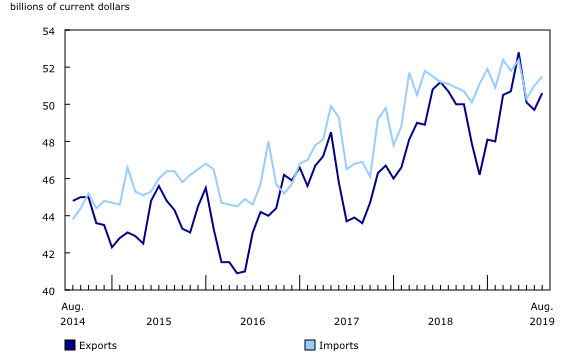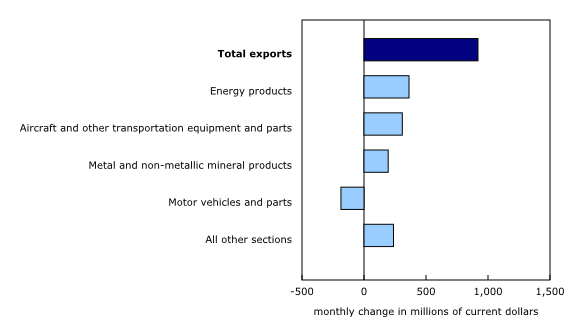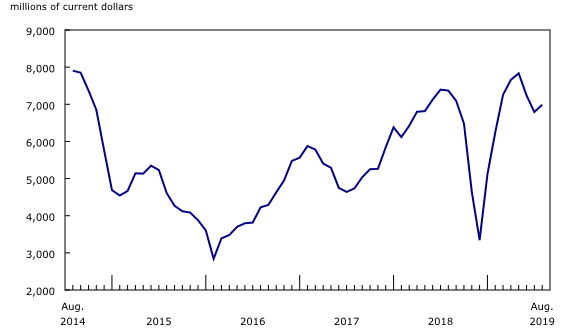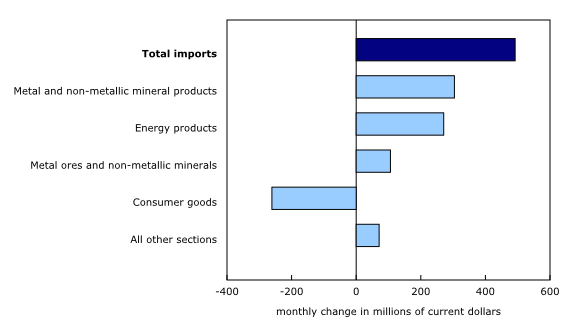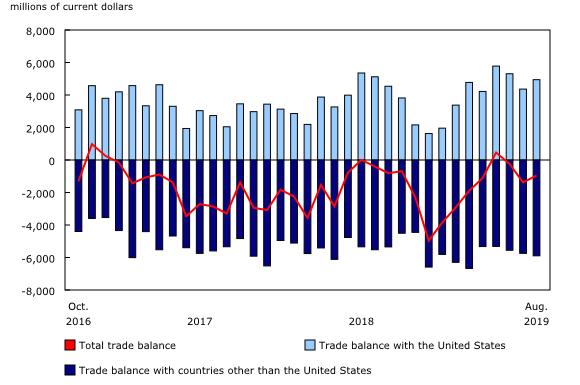Canadian international merchandise trade, August 2019
Archived Content
Information identified as archived is provided for reference, research or recordkeeping purposes. It is not subject to the Government of Canada Web Standards and has not been altered or updated since it was archived. Please "contact us" to request a format other than those available.
Released: 2019-10-04
Canada's exports rose 1.8% in August, mainly due to an increase in exports of energy products and aircraft. Imports were up 1.0%, mostly on higher imports of gold and crude oil. As a result, Canada's merchandise trade deficit narrowed from $1.4 billion in July to $955 million in August.
Exports increase after two months of declines
Following two consecutive monthly declines, total exports increased 1.8% to reach $50.6 billion in August. Gains were observed in 8 of 11 product sections and non-energy exports were up 1.4%. Year-to-date total exports in 2019 were up 2.4% compared with the same period in 2018. Despite the August increase in nominal terms, exports in real (or volume) terms edged down 0.2%.
After two months of strong declines, exports of energy products rose 3.9% in August. Exports of crude oil (+2.9%) led the increase, on the strength of higher prices. Crude oil export volumes were down, following several months of high levels. Exports of nuclear fuel (+109.7%) as well as refined petroleum products (+13.3%) also increased in August.
Exports of aircraft increased 38.7% in August, mainly on higher exports of business jets to the United States. Exports of aircraft have been volatile in 2019; overall they were up 4.6% in the first eight months of the year compared with the same period in 2018.
Exports of metal and non-metallic mineral products (+3.6%) also increased in August, with the majority of the product groups posting increases. Gold exports were responsible for more than half of the gain this month, as a result of higher prices. Prices for exports of gold were up in seven of the first eight months of 2019.
Lower exports of motor vehicles and parts (-2.3%) partially offset the increase in total exports. Exports of passenger cars and light trucks (-3.7%) were down in August as a result of prolonged summer shutdowns at certain assembly plants.
Higher imports of gold assets
Total imports increased 1.0% to $51.5 billion in August, with gains in 7 of 11 product sections. Total imports in the first eight months of the year were up 2.0% compared with the same period last year. In real (or volume) terms, imports rose 1.2% in August.
Higher imports of metal and non-metallic mineral products (+9.4%) were the main contributor to the overall gain in August, mainly on imports of gold, which reached their highest level in more than two years. These imports reflected an increase in gold asset acquisitions by Canadian companies in August.
Imports of energy products (+9.7%) also increased, mostly on higher imports of crude oil from the United States, Nigeria and Côte d'Ivoire. Higher imports of crude oil from abroad to Eastern Canadian refineries coincided with production disruptions in the Canadian North Atlantic oil platforms.
Imports of metal ores and non-metallic minerals (+8.8%) also contributed to the overall increase in August, due to higher shipments of copper ores from the Philippines.
These increases were partially offset by a 2.5% decrease in imports of consumer goods. After reaching a record high in July, imports of pharmaceutical products were down 15.8% in August, almost entirely reversing the gain recorded in the previous month.
Trade activity increases with the United States, decreases with other countries
Exports to the United States rose 3.1% in August, while imports were up 1.8%. As a result, Canada's trade surplus with the United States widened from $4.4 billion in July to $4.9 billion in August.
When the average exchange rates of July and August are compared, the Canadian dollar lost 1.0 US cent relative to the American dollar.
Exports to countries other than the United States fell 1.9% in August, the third consecutive monthly decline. Lower exports to Hong Kong (gold) and Italy (crude oil) were partially offset by higher exports to China (iron ores and potash) and the United Kingdom (gold).
Imports from countries other than the United States were down 0.5%. There were lower imports from Mexico (light-duty trucks), Norway (ships and motor gasoline) and Switzerland (pharmaceutical products) in August. As a result, Canada's trade deficit with countries other than the United States widened from $5.7 billion in July to $5.9 billion in August.
Revisions to July exports and imports
Revisions reflect initial estimates being updated with or replaced by administrative and survey data as they become available, as well as amendments made for late documentation of high-value transactions. Exports in July, originally reported as $49.8 billion in the previous release, were revised to $49.7 billion. Imports in July, originally reported as $50.9 billion in the previous release, were revised to $51.0 billion in the current month's release.
Note to readers
Merchandise trade is one component of Canada's international balance of payments (BOP), which also includes trade in services, investment income, current transfers, and capital and financial flows.
International trade data by commodity are available on both a BOP and a customs basis. International trade data by country are available on a customs basis for all countries and on a BOP basis for Canada's 27 principal trading partners (PTPs). The list of PTPs is based on their annual share of total merchandise trade—imports and exports—with Canada in 2012. BOP data are derived from customs data by making adjustments for factors such as valuation, coverage, timing and residency. These adjustments are made to conform to the concepts and definitions of the Canadian System of National Accounts.
For a conceptual analysis of BOP versus customs-based data, see "Balance of Payments trade in goods at Statistics Canada: Expanding geographic detail to 27 principal trading partners."
For more information on these and other macroeconomic concepts, see the Methodological Guide: Canadian System of Macroeconomic Accounts (13-607-X) and the User Guide: Canadian System of Macroeconomic Accounts (13-606-G).
Data in this release are on a BOP basis and are seasonally adjusted. Unless otherwise stated, values are expressed in nominal terms, or current dollars. References to prices are based on aggregate Paasche (current-weighted) price indexes (2012=100). Volumes, or constant dollars, are calculated using the Laspeyres formula (2012=100).
For information on seasonal adjustment, see "Seasonally adjusted data – Frequently asked questions."
Revisions
In general, merchandise trade data are revised on an ongoing basis for each month of the current year. Current-year revisions are reflected in both the customs and BOP-based data.
The previous year's customs-based data are revised with the release of the January and February reference months, and thereafter on a quarterly basis. The previous two years of customs-based data are revised annually, and revisions are released in February with the December reference month.
The previous year's BOP-based data are revised with the release of data for the January, February, March and April reference months. To remain consistent with the Canadian System of Macroeconomic Accounts, revisions to BOP-based data for previous years are released annually in December with the October reference month.
Factors influencing revisions include the late receipt of import and export documentation, incorrect information on customs forms, replacement of estimates produced for the energy section with actual figures, changes in classification of merchandise based on more current information, and changes to seasonal adjustment factors.
For information on data revisions for crude oil and natural gas, see "Revisions to trade data for crude oil and natural gas."
Revised data are available in the appropriate tables.
Real-time data table
Real-time table 12-10-0120-01 will be updated on October 15.
Next release
Data on Canadian international merchandise trade for September will be released on November 5.
Products
The product "International Trade Explorer" (71-607-X) is now available online. This product provides a new way of looking at Canada's trade relations. Leveraging the analytical richness of customs data, this product offers four different visualization tools: an interactive world map, a tree map, a stacked bar chart and a visualization tool for trade by province.
Customs-based data are now available in the Canadian International Merchandise Trade Database (65F0013X).
The updated Canada and the World Statistics Hub (13-609-X) is now available online. This product illustrates the nature and extent of Canada's economic and financial relationship with the world using interactive graphs and tables. This product provides easy access to information on trade, investment, employment and travel between Canada and a number of countries, including the United States, the United Kingdom, Mexico, China, Japan, Belgium, Italy, the Netherlands, Spain and many others.
Contact information
For more information, or to enquire about the concepts, methods or data quality of this release, contact us (toll-free 1-800-263-1136; 514-283-8300; STATCAN.infostats-infostats.STATCAN@canada.ca) or Media Relations (613-951-4636; STATCAN.mediahotline-ligneinfomedias.STATCAN@canada.ca).
- Date modified:



